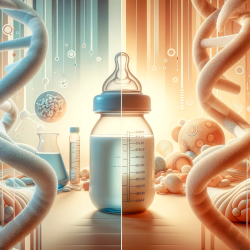Lactation Report Description

The NutraHacker Lactation Report is a genetic report that identifies single nucleotide polymorphisms (SNPs) that have an influence on lactation or the breastfed infant. These genes relate to the mother and do not analyze genetics of the child.
SNPs starred with an asterisk (*) have been calculated using impute software.
Imputed alleles are phased, meaning it can be discerned which gene copy caries a particular allele. Phasing separates maternally and paternally inherited copies of alleles so that haplotypes can be determined.
Conventionally, major/minor allele is selected as the predominant allele versus less common allele in a particular population, and this can vary depending on the population assessed.
In this report, the majority of "expected" alleles come from the major allele and variant is minor allele, however in certain circumstances it was found that the minor allele provides a benefit and is selected as expected or "beneficial" allele. We refer to these as "expected" and "variant" allele.
This report is provided for informational purposes, speak with your doctor if you would like further understanding or guidance. This report should not be used to make any changes to diet or breastfeeding without consulting under the care of a licensed physician or nutritionist.
A sample Lactation report can be accessed by clicking here.
Helpful excerpts from various publications:
Secretor: The activity of alpha-[1,2]-fucosyltransferase, encoded by the FUT2 gene, determines "secretor" versus "nonsecretor" status and HBGA expression. Secretors can express 2-fucosylated oligosaccharides in breast milk and H-type 1 antigens on mucosal surfaces. Homozygotes for inactivating alleles in FUT2 are characterized as nonsecretors and lack this ability but seem to be protected against symptomatic RV infections.
Maternal Secretor Status Affects Oral Rotavirus Vaccine Response in Breastfed Infants in Bangladesh
Fucosylated oligosaccharides are decoy receptors for many pathogenic bacteria, including members of enterobacteria; hence, they have a potential to reduce their adhesion to the gut, thus protecting the infant. In addition, fucosylated HMOs bind enterotoxin produced by E. coli.
Fucosylated oligosaccharides in mother's milk alleviate the effects of caesarean birth on infant gut microbiota
What are the benefits of human milk oligosaccharides?
Several studies have reported the health benefits of HMOs, which include modulation of the intestinal microbiota, anti-adhesive effect against pathogens, modulation of the intestinal epithelial cell response, and development of the immune system.
The Role of Two Human Milk Oligosaccharides, 2'-Fucosyllactose and Lacto-N-Neotetraose, in Infant Nutrition
The results indicate that maternal secretor status may be particularly influential in infants with compromised microbiota development, and that these infants could benefit from corrective supplementation.
The combination of caesarean birth and lack of milk 2'FL appear to profoundly alter the infant's microbiota. The FUT3 enzyme determines the Lewis type (Le), resulting in strong reduction of alpha-1,3 and absence of alpha-1,4 fucosylated HMOs in milk. Lewis and Secretor type thus allow grouping of human milk in four main milk groups, also sometimes named 'lactotypes'.
Biology of human milk oligosaccharides: From basic science to clinical evidence
The importance of functional Se and Le genes in infant development is an area of active research. One study showed that maternal secretor status appeared to be important for preventing diarrhea, as although the gut microbiota measured through 16S rRNA sequencing did not differ between infants of Se+ and Se- mothers, the prevalence of diarrhea was higher among infants of Se- mothers (18). Moreover, when these infants were provided iron supplements, infants of Se- mothers were more likely to experience a decrease in the abundance of Bifidobacterium and an increase in pathogens compared to infants of Se+ mothers (18). However, supplementation with galactooligosaccharides appeared to ameliorate the impact of iron supplementation (18).
In terms of the oligosaccharides and their metabolites, 3'galactosyllactose, 3'SL, fucose, and LNnT were between 2- and 10-fold lower in milk samples from Se-Le- and Se-Le+ compared to Se+ mothers. Galactose was 6 and 1 times higher in milk samples from Se-Le- and Se-Le+ mothers, respectively, compared to samples from Se+ mothers. For metabolites associated with energy metabolism, samples from Se-Le- milk were approximately 4 times higher in creatine phosphate, 12 times higher in creatine, 4 times higher in creatinine, 5 times higher in citrate, 6 times higher in pyruvate, and 10 times higher in succinate compared to Se+ milk, while these metabolites were similar in concentration between milk from Se-Le+ and Se+ mothers.
The Milk Metabolome of Non-secretor and Lewis Negative Mothers
Helpful reading:
Genetic and Physiological Factors Affecting Human Milk Production and Composition
Review of Infant Feeding: Key Features of Breast Milk and Infant Formula
Human milk oligosaccharides: Every baby needs a sugar mama
The Milk Metabolome of Non-secretor and Lewis Negative Mothers
Human Milk Oligosaccharides and Lewis Blood Group: Individual High-Throughput Sample Profiling to Enhance Conclusions From Functional Studies
The Impact of Dietary Fucosylated Oligosaccharides and Glycoproteins of Human Milk on Infant Well-Being
Influence of Gestational Age, Secretor, and Lewis Blood Group Status on the Oligosaccharide Content of Human Milk
Innate protection conferred by fucosylated oligosaccharides of human milk against diarrhea in breastfed infants
The Impact of Dietary Fucosylated Oligosaccharides and Glycoproteins of Human Milk on Infant Well-Being
Genes covered in the Lactation Report include:
- ABCG2
- BHMT
- CHDH
- CHKA
- ELOVL2
- ELOVL5
- FADS1
- FADS2
- FADS3
- FMO3
- FTO
- FUT2
- FUT3
- MFGE8
- MTHFD1
- MTHFR
- MTR
- MTRR
- OXTR
- PEMT
- SLC30A2
- SLC4A1
- SLC5A5
- SLCA5
Upload raw DNA data to get your very own personalized Lactation Report at the NutraHacker Store.